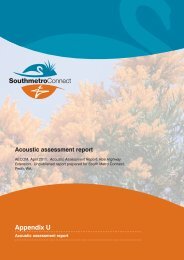Existing Environment - Interactive Investor
Existing Environment - Interactive Investor
Existing Environment - Interactive Investor
Create successful ePaper yourself
Turn your PDF publications into a flip-book with our unique Google optimized e-Paper software.
Water levels in Bibra Lake have maintained a repeatable pattern of highs and lows<br />
over the seasons, as well as within a 20-year cycle; however, there are not enough<br />
years of data to conclude whether this is a consistent pattern.<br />
Historical aerial photography (Figure 5.6-8 through to Figure 5.6-14) shows various<br />
water levels in the lakes over time. The figures include the MRS road reserve<br />
boundary to provide context. Although taken at differing times of the year, the aerial<br />
images show that the water level in North and Bibra lakes has remained relatively<br />
similar over most years. During winter 2010, water levels were dry or low in the<br />
lakes. Low water levels indicated on aerial photography from 1978 (Figure 5.6-11)<br />
are consistent with the readings down to RL (Reduced Level) 12.5m Australian Height<br />
Datum (AHD) in 1978 (Figure 5.6-7). Variations in water level appear in the<br />
surrounding wetlands:<br />
Horse Paddock Swamp and Murdoch Drain had evident surface water in the<br />
1947/1948, 1970 and 1989 photos;<br />
Lower Swamp and Roe Swamp had evident surface water in the 1978 photo, with<br />
only a small area of surface water in Horse Paddock Swamp and Murdoch Drain;<br />
None of the peripheral swamp systems showed obvious surface water in the<br />
1958/1959 photo or the 1999 photo; and<br />
The only surface water showing in the 2008 historical aerial photograph was in the<br />
lower end of Murdoch Drain; there is no obvious surface water in the other<br />
peripheral swamp systems.<br />
While the water levels in the lakes appear to have been relatively consistent, these<br />
variations in surface water within the peripheral systems indicate a shallow surface<br />
water system sensitive to groundwater expression and surface water contributions.<br />
Alternatively, it may be due to natural vegetative succession, as a result of changing<br />
land use practices.<br />
Water levels in North and Bibra lakes appear less sensitive to change, possibly<br />
reflecting their larger storage volumes and deeper vertical profiles. Conversely, the<br />
peripheral swamps have smaller storage volumes, varying base levels and varying<br />
interfaces with the surrounding topography. Therefore, whether surface water shows<br />
or not depends on the rising groundwater intrusion through variably pervious wetland<br />
sediments and runoff generated in adjacent catchment areas.<br />
136





